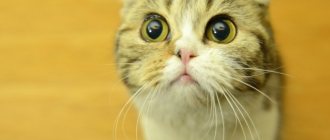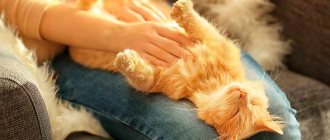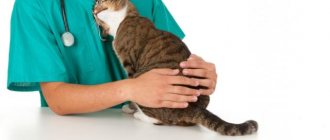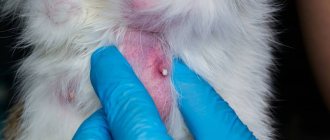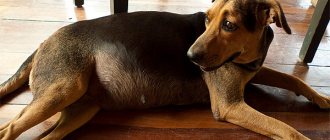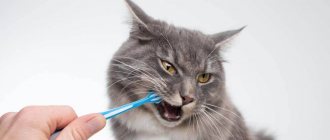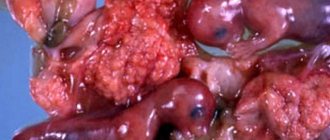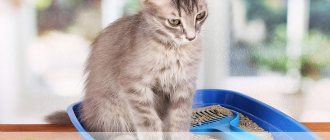INCREASE IN ABDOMINAL VOLUME can occur for a variety of reasons and over various periods of time - from several hours to several weeks.
In general, this condition can be observed for the following reasons:
- increase due to voluminous internal formations: pregnancy, (especially multiple pregnancy), large tumor, greatly enlarged uterine horns with its purulent inflammation - pyometra, significant accumulations of gas in the stomach and intestines, stagnation of feces, sharply enlarged bladder with acute urinary retention or atony. In some cases, large hernias can also simulate an enlarged abdomen.
- increase due to sagging of the abdominal wall: with endocrine diseases - for example, with hypothyroidism, Cushing's syndrome; Obesity manifests itself in a similar way.
– an increase due to the accumulation of fluid in the abdominal cavity (the nature of the fluid can be different - inflammatory and non-inflammatory (transudate, exudate, modified transudate). In this way, infectious peritonitis of cats, hemoabdomen (accumulation of blood in the abdominal cavity during bleeding), ascites in pathology can manifest liver (for example, cirrhosis), heart failure, neoplasms and other diseases.
Breed characteristics
Some breeds have a fold in the abdominal area their entire life. And, by the way, there is nothing reprehensible in this, since natural affiliation simply obliges you to “possess” a fat tail.
Do not be upset if the skin hangs on the belly of a cat of the following breeds: Canadian Sphynx, Pixie-Bob, Bengal, Scottish Straight, Scottish Shorthair. The reasons for the presence of loose skin in pets of these breeds are unknown. Probably, the fat layer should protect short-haired and hairless individuals from the cold, and for others, the fat tail should protect the abdominal organs from injury during fights.
Important! You should not try to reduce a saggy belly by starving your pet. With such a diet, the skin will not go anywhere, but, on the contrary, will become even more noticeable on a body that is too thin
In those cats that, by their breed vocation, are forced to “wear” a fat tail, the stomach decreases during the lactation period. As soon as the feeding of the kittens stops, the size of the saggy tummy returns to normal.
Feeding cheap foods
Veterinarians strongly recommend analyzing your pet’s diet. After all, unhealthy food from economy class (Whiskas, Felix, Kitekat) will sooner or later cause disruption of the digestive tract. Along with the indicated nutrition, the foods that people love to feast on are harmful. Sausages, dairy products, soups and main courses from the human table are not suitable for consumption by animals. Pathologies of the gastrointestinal tract can easily lead to the death of a cat. High-quality industrial food that will not harm your pet - Akana, Hills, Perfect Fit, Purina Van and other branded products from the premium, superpremium segment. If the owner’s choice is made in favor of natural nutrition, then among the healthy foods for the mustachioed pet can be noted: cereals (rice and oatmeal), meat (beef, turkey, rabbit), stewed vegetables (carrots, cabbage, beets). It is necessary to remember the basic rule: mixing natural food and ready-made food is prohibited.
If your cat has sagging skin on its belly despite a well-thought-out diet, then you should slightly reconsider its diet.
It is important to reduce the calorie content of dishes by reducing the amount of meat component to 50-70%
When a hanging belly is normal
When the belly does not hang much, the cat’s health is normal, then there is no need to worry. In most cases, fat tail is a feature of the body associated with age, physiological changes, and breed predisposition.
| sudden weight loss | proper diet and physical activity force an obese cat to quickly lose weight, and a hanging belly remains a reminder of its former fatness, which gradually tightens in young cats; but if weight loss is not related to diet, and your pet develops suspicious symptoms, contact your veterinarian immediately |
| multiple or large pregnancy | when carrying 8-10 babies or producing large fetuses, the stretched uterus causes the abdominal walls to expand; the belly can sag during normal pregnancy, if the female has a miniature build; a predisposition to multiple pregnancies is a desirable feature of breeding cats; breeders prefer to breed females with a noticeable fat tail |
| castration | deprivation of reproductive ability is a serious blow to hormonal levels; a neutered pet becomes gluttonous, less physically active, and gains extra pounds, leading to a sagging belly |
| aging | in older cats, the synthesis of collagen fibers inevitably decreases, the skin loses its elasticity, gradually stretches downwards, as a result, the fat tail becomes more noticeable |
| breed feature | a noticeably hanging belly is the norm for the Canadian Sphynx, Bengal, British, Pixie Bob, Canaan, Straight-eared Scots, Chausie, Savannah, Cornish Rex, the listed breeds are closely related to wild relatives, passing on the external feature to their descendants; In Scots of the American line, the fat tail is unexpressed, since aboriginal cats with a similar feature were used for breeding, and in European individuals, the pouch is noticeable even in a kitten, because the ancestor is a British cat |
Diagnostics and therapy
To make a diagnosis, blood, urine and feces are examined, ultrasound and x-rays are done. During the examination, the veterinarian palpates and listens to the peritoneum. Depending on the results that explain why the cat has a hard stomach, the doctor decides what to do to normalize his condition.
Help with non-dangerous causes of bloating
Flatulence caused by poor nutrition can be eliminated by adjusting the diet. A ban is imposed on any products that increase gas formation (legumes, flour, fresh vegetables). Remember that milk is contraindicated for adult animals, as they develop lactose intolerance. To normalize intestinal function, your veterinarian may recommend a course of probiotics.
Excessive weight can be eliminated by reviewing your diet. The animal is prescribed less high-calorie food and the usual portions are reduced. Daily physical activity is complemented by joint games.
A big belly in a scared cat can be healed with time. Do not impose your affection and let your pet get used to the unfamiliar environment.
Treatment of the underlying disease
Surgery will be required to eliminate pyometra. During the operation, the veterinarian cuts out the uterus, that is, performs sterilization. Surgeries are also necessary to remove a tumor, intestinal obstruction, foreign object, or the consequences of severe trauma.
All infectious diseases are treated with antibiotics and antiviral drugs, and helminthiasis with anthelmintics. Intoxication with poisons is eliminated by administering an antidote and gastric lavage. In case of ascites, excess fluid is pumped out of the animal and a course of diuretics is prescribed.
To treat constipation, use Vaseline oil or laxatives. Such therapy is permissible only in the absence of intestinal obstruction. Otherwise, taking these drugs may cause intestinal rupture.
Treatment for an abscess depends on its complexity. Most often, drug therapy, which involves taking antibiotics and anti-inflammatory drugs, is sufficient. In case of extensive inflammation, the ulcers are removed by a surgeon.
Cholecystitis is treated with antibiotics and proper nutrition. The animal is transferred to a veterinary food that fights gallstones.
Any therapy must be carried out under the supervision of a veterinarian, with dosages clearly specified by him.
Why does deviation occur?
The development of the deviation is influenced by pathological and physiological factors. The first are dangerous to health and require the intervention of a veterinarian. The latter are natural, so they are easy to figure out on your own.
Hazardous factors
The presence of pathology is indicated when the abdominal muscles do not relax for more than a day, and the pet’s condition gradually worsens. This is due to the following reasons:
Constipation
. It occurs due to intestinal spasms, improper feeding, ingestion of a foreign object, helminthiasis and the accumulation of hair in the intestines during heavy shedding. Without prompt treatment, constipation can lead to intestinal obstruction and death.
Peritonitis
. The peritoneal mucosa becomes inflamed upon contact with gastric or intestinal contents. The penetration of foreign microflora is fraught with epithelial detachment and necrosis.
Poisoning
. Against the background of acute intoxication, painful spasms occur in the lower part of the stomach.
Abscess
. The danger of purulent formation in the abdominal organs lies in its rupture and subsequent blood poisoning.
Injury
. When internal organs are damaged, their contents leak into the peritoneum. The further reaction is similar to peritonitis.
Cholecystitis (biliary colic)
. Inflammation of the gallbladder occurs when there is excessive production of bile or the formation of stones. The patient's peritoneum hardens and excruciating pain occurs.
Pyometra
. Purulent inflammation in the uterus appears with frequent mating, hormonal disorders and infections.
Ascites (abdominal dropsy)
. With this disease, free fluid accumulates in the abdominal cavity. Most often this occurs as a result of poor circulation.
Neoplasms
. The growth of the tumor is reflected in the size of the peritoneum. Most often, neoplasms occur in older animals.
Panleukopenia (distemper)
. Infection with the virus occurs in utero, during a bite by a blood-sucking insect, or through contact with an infected animal or its biological fluids.
All these causes can be eliminated with medication. Without timely help, even simple constipation becomes dangerous.
Non-hazardous factors
An enlarged and dense belly in a cat also appears for natural reasons. These include:
Flatulence
. A tight stomach appears when there is an excess accumulation of digestive gases. Usually this condition goes away with dietary adjustments, but sometimes it is a sign of helminthiasis, dysbacteriosis, intestinal obstruction and other diseases.
Pregnancy
. Shortly before childbirth, the size of the uterus increases greatly. The abdominal muscles become harder to protect the kittens inside the womb. The condition returns to normal a few hours after the birth of the offspring.
Stress
. By tensing the abdominal muscles, the pet tries to protect itself from the source of fear or unpleasant touches. This behavior is typical for animals that have suffered physical abuse.
Obesity
. If the pet is neutered and inactive, then it quickly gains weight. This situation can be easily managed with diet and increased activity. Remember that the lack of response threatens premature death from fatty degeneration of the myocardium, that is, obesity of the heart.
Associated symptoms will help distinguish pathological factors from physiological ones. If they are detected, you must immediately contact a veterinary clinic.
Diagnostics
Diagnosis of bloating must be comprehensive and include blood tests (general and biochemical), urine, abdominal ultrasound and x-rays. In some cases, especially if neoplasms are suspected, a CT scan is recommended.
The following are the primary diagnostic methods, depending on the suspicion of various causes of bloating:
- Obesity – weighing the pet, analyzing the diet, palpation;
- Pregnancy - ultrasound of the abdominal cavity;
- Flatulence - diet analysis, abdominal ultrasound;
- Viral disease - specific virological tests (PCR test of blood and effusion);
- Neoplasm – ultrasound of the abdominal cavity, plain X-ray in three projections, CT in the “oncology search” mode;
- Heart diseases – cardiac ECHO;
- Liver diseases - general and biochemical blood tests, ultrasound of the abdominal cavity;
- Kidney diseases - general and biochemical blood tests, abdominal ultrasound, urinalysis;
- Coprostasis – abdominal x-ray;
- Injuries – ultrasound of the abdominal cavity;
- Pyometra - ultrasound of the abdominal cavity;
- Helminthic infestation - stool analysis.
Signs of pathology
A cat's enlarged belly should be the reason for an unscheduled visit to the veterinarian. Sometimes, if the outflow of urine is disrupted or the intestines are blocked, a timely operation can save the life of a pet.
Why do certain pathologies develop if, in the opinion of the owners, the animal is well cared for? The causes of the development of diseases accompanied by enlargement of the peritoneum are:
- poor nutrition, lack of animal access to water;
- non-compliance with the schedule of vaccination and anthelmintic measures;
- peritoneal injuries;
- development of chronic diseases of internal organs.
There are a number of symptoms, the occurrence of which requires urgent consultation with a veterinarian. These include:
- diarrhea;
- vomit;
- apathy;
- increase in body temperature (hot, dry nose and ears);
- lack of appetite;
- the presence of blood, parasites and their eggs in the stool or urine.
Symptoms indicating illness
In addition to the duration of the bloating, it is important to consider any warning signs. Possible pathology is indicated by:
- inflammation, yellowing or blue discoloration of mucous membranes;
- too rapid enlargement of the peritoneum or sudden weight loss;
- frequent vomiting, diarrhea, or lack of bowel movements for more than 2 days in a row;
- lethargy and fever;
- pain when emptying the bowel or bladder;
- dullness and hair loss;
- foam, blood or parasites found in vomit and feces;
- increased thirst and loss of appetite;
- profuse drooling;
- severe pain in the abdominal area upon palpation.
If a pregnant cat's swollen belly does not return to normal within 1.5 days after birth, call a veterinarian. This condition is typical for unfinished labor. The stuck fetus will have to be removed surgically.
What is a cat's fat tail?
A cat's fat tail is scientifically called a “primordial pouch,” which means a genetic tendency in some cat breeds to form a fold of skin on the abdomen, between the hind legs.
A small hanging tail is considered normal for cats if it is elastic, soft to the touch, does not cause pain and its size does not exceed 5 cm.
In felinology, there are several theories that explain this anatomical feature in cats:
- The inguinal skin fold is a “depot” for fat deposits, which are consumed during prolonged fasting of a cat, which allows animals to survive in the most difficult circumstances. Fat deposits in cats are especially noticeable during the winter cold.
- The fat tail acts as a repository of excess elastic skin, which is actively used when jumping high, long, while climbing trees or when entering narrow crevices, when the cat needs to stretch out “in line” to get to the desired place.
- A hanging belly in cats is an additional means of protecting internal organs during fights and fights with relatives. Cats tend to deliver powerful blows to the enemy with their hind legs, and an additional layer of skin will protect the vulnerable belly from damage to internal organs.
All domestic and wild cats have a fat tail, but in some it is more pronounced due to breed or physiological characteristics, in others it is less pronounced.
In spring and summer, the size of the saggy tummy in cats is significantly reduced, and in late autumn and winter the fat tail grows again.
Why does the cat have a fat belly?
Just like people, pets can have different body types and reasons that determine where fat deposits will accumulate - on the stomach in cats or in other parts of the body. As we have already said, some cats have a hanging belly, and some have a wider belly. This largely depends on the exterior and breed.
Body features are described by terms that characterize the types of constitution: loose (raw), rough, strong, dry. At the same time, for example, the raw type is characterized by more flabby muscles and a slower metabolism; in such a cat, belly fat will accumulate more under the skin and sag significantly. The rough type is characterized by thick skin and highly developed bones; such cats are more likely to be evenly rounded, including on the stomach.
Fat can accumulate in the subcutaneous tissue, then to the touch it seems that soft fluffy bags form in the animal’s lower abdomen, closer to the hips, where the skin fold is. Many owners are frightened by their appearance, but this is the most typical place for fat accumulation in cats.
Fatty tissue also accumulates in places where it cannot be seen—inside the body and on internal organs, including the kidneys and heart. A particularly large amount of fat accumulates on the omentum - connective tissue folds located in the abdomen near the intestines. It is because of the omentum that the belly of fat cats looks so round, tight and elastic, even if not much fatty tissue can be felt under the skin.
What to do:
- in all cases of abdominal enlargement, it is necessary to consult a doctor, regardless of the age of the animal - there are no options for “it will resolve on its own”!
– the faster the belly enlarges, the more urgent it should be to see a doctor. If there is a simultaneous significant deterioration in your health, you must go immediately to the clinic, where an ultrasound/X-ray and, if necessary, surgery can be performed.
– to independently monitor the amount of fluid in the abdominal cavity, you can use weighing + measuring the volume of the abdomen with a centimeter tape. Nevertheless, primary importance when choosing treatment tactics is given to the general condition of the animal and the degree of tension in the abdominal wall, and not to weight/volume.
Can ascites in cats be treated or not?
Treatment of ascites is carried out comprehensively. Therapy is aimed at eliminating the underlying disease, alleviating pain symptoms and strengthening the immune system.
To reduce the amount of fluid in the abdominal cavity, laxatives and diuretics (Furosemide, Temisal) are indicated.
To stabilize the functioning of the cardiovascular system, drugs such as Olitorizide, Strophanthin, Digitoxin, Cardiovalen are necessarily prescribed.
If there is an infection in the body, antibiotic therapy using drugs from a number of cephalosporins is indicated.
To strengthen the walls of blood vessels and reduce their permeability, the veterinarian prescribes intravenous solutions of calcium chloride (10%).
To pump out the fluid, a puncture is done when the veterinarian pierces the abdominal wall. The procedure is performed at least twice a week. In this case, the removal of ascitic fluid must be compensated by reinfusion of ascitic transudate or administration of an albumin solution. These procedures provide a chance for additional remission and prolongation of the animal’s life.
The course of treatment depends on the condition of the animal and the amount of fluid. This is a long process that must continue until the clinical signs of dropsy completely disappear.
As for the prognosis, with adequate and, most importantly, timely therapy, it is favorable. If you do not seek help from a specialist in time, the volume of fluid will continue to increase, and this is fraught with pressure on the internal organs and disruption of their functions.
Symptoms of ascites
The first and most obvious signs of ascites are the following symptoms:
- swollen, tight stomach (“bulging” sides);
- poor appetite (sometimes complete refusal to eat);
- flatulence, constipation, diarrhea;
- vomiting (most often with saliva);
- depressed mood (anxiety, sadness, apathy, etc.) due to abdominal pain;
- heavy breathing (rapid breathing, with wheezing, groaning, coughing, etc.);
- the cat tries to lie on its side;
- caution in movements (slow gait, uncertain steps, etc.);
- refusal to play and fatigue;
- weakness (fainting is also possible).
Some owners may mistake dropsy for the first signs of pregnancy (in cats), helminthic infestation, or flatulence. To make sure that it is definitely not gases or a fetus, it is enough to take the sick cat in your arms. In an animal in an upright position, the fluid will flow into the lower abdomen. As soon as you place the cat on the floor, the water will again be distributed throughout the abdomen.
Photo gallery: some signs of ascites in cats
With ascites, the cat's stomach "swells" A sick cat may become apathetic or aggressive If ascites, a cat may have diarrhea or, conversely, constipation Cats with dropsy do not eat well, sometimes completely refuse to eat A sick cat may cough or have difficulty breathing
It is important to recognize dropsy immediately and contact a veterinarian, because time may not be in your favor. For example, in cats with diabetes, the volume of fluid can reach 2-3 liters (the larger the cat, the more fluid) in just 2-3 days.
Cat diseases part 2
Cystitis is an inflammation of the bladder mucosa caused by various reasons (inflammation of nearby organs - kidneys, uterus, etc.; injuries, irritants, etc.). The cat urinates with difficulty and often, possibly with blood, the temperature rises, and the bladder area is painful. While waiting for the veterinarian, you can give a drug with a general antiseptic effect - methenamine. You need to follow a diet - exclude meat for a while, replacing it with vegetable broth, switch to dairy foods.
Nephritis - can develop with plague, bronchopneumonia, or as a result of injury. The animal is depressed and has no appetite. Vomiting, difficulty moving the hind limbs. Urination is frequent and copious, often bloody urine, rapid breathing. Call a doctor immediately! Keep your cat warm and give her tea. Treatment should be started as soon as possible, as uremia may develop.
Bladder stones are common in cats, especially older ones. Urolithiasis manifests itself in difficult and painful urination. Treatment by a veterinarian is necessary, since an overfilled bladder can burst, and in general this is a serious metabolic disorder. A strict diet is required depending on the composition of the stones.
Eye diseases
Such diseases should be treated by a specialist. Depending on the diagnosis, he prescribes the necessary eye medications. It is very dangerous to show independence in treatment, since incorrect actions can cause a deterioration in the animal’s condition. The most common eye diseases are watery eyes (epiphora), conjunctivitis, eye damage, foreign body in the eye, third eyelid prolapse.
Lacrimation (epiphora).
Epiphora refers to lacrimation that goes beyond normal limits. Tears are a response to irritation. The causes of lacrimation can be: allergies, inflammation of the connective membrane of the eyes, conjunctivitis, damage to the cornea, blockage of the tear ducts. In addition, lacrimation can be a symptom accompanying mild infectious diseases, such as those of the upper respiratory tract.
Sometimes watery eyes cause a change in the color of the fur under the eyes, so the hair in these areas must be thoroughly washed, and in some cases even shaved.
Conjunctivitis is an inflammation of the cornea of the eye. It can occur as an independent disease, but can accompany infectious diseases. The first sign of inflammation of the cornea is lacrimation. In mild cases, conjunctivitis may go away on its own within 3-7 days, and in others, tear secretions become sticky, yellowish, and accumulate in large quantities in the corners of the eyes, then treatment is necessary.
In order to cure a cat of conjunctivitis, it is first necessary to eliminate the cause that caused it.
In a healthy cat, discharge from the eyes should be clear and watery; in a cat with conjunctivitis, it is usually sticky and opaque. If conjunctivitis does not go away within three days, you should consult a doctor. He will prescribe antibiotics, eye drops, and explain how to wash the eyes.
Damage to the eye, foreign body in the eye.
Severe watering and inflammation of the cornea may be signs that a foreign body has entered the eye or that the eye is damaged.
If lacrimation and inflammation of the cornea are accompanied by pain when blinking or washing with a paw, there is every reason to assume that the eye is damaged or a foreign body has entered it.
An eye examination to determine the causes of lacrimation must be carried out in bright light. To remove a foreign body, place the thumb of one hand on the edge of the lower eyelid and the thumb of the other hand on the edge of the upper eyelid. By pulling back the eyelids, you can examine the eyeball.
Compare the damaged eye with the healthy one. In a healthy eye, the upper surface of the cornea should be smooth and completely transparent.
If you find, for example, a speck or grain of sand in your cat's eye, carefully remove it with a damp gauze swab, moving it along the inner surface of the eyelid to the corner of the eye. If the foreign body is large, it can be removed with tweezers or even your fingertips.
If you are unable to remove the foreign body yourself, you should immediately consult a doctor.
Prolapse of the third eyelid.
The third eyelid (blinking eyelid) quite often falls out of its normal state at the inner corner of the eye and forms folds, sometimes covering part of the eye. Very often this is a sign of local irritation of the eye, for example, when a foreign body enters the eye or when the cornea is damaged.
Sometimes this happens in both eyes at the same time and lasts quite a long time - from several hours to several days. The cause of third eyelid prolapse may be a disorder of the gastrointestinal tract; other signs are loss of appetite, loose stools, vomiting.
After normal activity of the stomach and intestines is restored, the third eyelid returns to its normal position.
For more serious symptoms (high temperature, weight loss, complete lack of appetite), you should immediately consult a doctor.
Prolapse of the third eyelid can sometimes occur in a healthy cat. It usually goes away without treatment. Observe the cat for 1-2 days. If it does not go away within this time, you should consult a doctor, as this may indicate the onset of some disease and lead to undesirable consequences.
Ear diseases
Ear diseases in cats are quite common. The ear is a complex and delicate instrument that must be handled with great care. Ulcers may occur in the ears, the cat may develop ear scabies, otitis externa and otitis media, swelling in the ears may occur due to abscesses and hematomas, and foreign objects may enter the ear.
Ulcers.
When an ulcer occurs in the ear, a foul-smelling, thick discharge appears that dries, forming scabs at the entrance of the auricle. The cat scratches its ear with its paw and shakes its head. A more thorough examination of the ear will reveal significant ulceration.
Do not treat it yourself - take your cat to a veterinarian.
Ear scabies.
It is caused by very small reddish-brown mites, which cause great concern to the animal. The first symptom is ear twitching or violent head shaking. Later, the animal begins to intensively scratch its ear.
As first aid, you can use warm vegetable or olive oil (3-4 drops), which will soften the scab and make the animal feel better. More details
Otitis is an inflammatory process in the ear. A distinction is made between external otitis, which is inflammation of the part of the ear located outside the eardrum, and medial, which is inflammation of the middle ear.
The reasons that cause otitis in a cat can be different, but most often it is an ear mite or a foreign body that has entered the ear.
A cat with otitis media usually shakes its head and scratches its ears with its paws. Sometimes with this disease she holds her head a little to one side, since any change in the position of her head causes her pain.
With otitis media, discharge from the ears may also be observed, in severe cases even purulent. The inner side of the auricle of the affected ear is bright pink or red, swelling may be clearly visible, and an odor appears from the ears.
Otitis requires immediate and vigorous treatment, as it easily becomes chronic and can lead to irreversible changes in the hearing organs.
When treating otitis at home, use 70% isopropyl alcohol or medical alcohol, which is used to clean the ears 2 times a day. After cleaning, 1-2 drops of alcohol can be dropped into the ear and massaged at the base of the cat’s ears in order to enhance the effect of the medicine.
If there is no improvement after 3 days, you should consult a doctor. More details
Swelling on the ears occurs in cats in most cases due to abscesses. Abscesses are called abscesses, ulcers, accumulations of pus in organs or tissues as a result of the inflammatory process. Less commonly, swelling can occur due to a bloody blister that forms between the layers of the ear - a hematoma. The cat may develop severe scratching and even cysts; the animal, trying to get rid of the itching, constantly shakes its head.
If the cat does not have a fever or discharge from the swollen part of the tissue, then without the help of a doctor you will not be able to distinguish an abscess from a hematoma. For a hematoma, it is recommended to use cold lotions. Then you must immediately consult a doctor, otherwise the hematoma can lead to ear deformation.
The hematoma is often removed surgically or a special ointment prescribed by a doctor is applied, which has to be used for quite a long time, sometimes several weeks.
Foreign objects in the ear, such as plant particles or awns of grasses and spikelets, can lead to intense irritation. And if thorns get into the ear, the problem may worsen. All you need to solve it is good lighting, your calmness and a keen eye.
Diseases of the nose
These diseases are quite rare in cats. Most often they accompany other diseases. Nevertheless, any owner needs to know about them.
Sticky, watery, milky-white to yellowish discharge from the nostrils, sneezing, as a rule, are signs of some kind of infectious disease or disease of the upper respiratory tract.
Oral diseases
These diseases are often accompanied by difficulty eating, drooling, difficulty swallowing and bad breath. The origin of these diseases is different. These are inflammations, foreign bodies, tartar.
Inflammation.
Most often there is inflammation of the edges of the lips, gums, oral mucosa (including the tongue), tonsils and pharyngeal cavity. These diseases must be treated by a veterinarian who will determine whether they are infectious or not.
Inflammation of the gums (gingivitis).
Red, bloodshot gums can be a sign of gingivitis.
Only a specialist can make an accurate diagnosis. Since it is very difficult to carry out treatment at home, in such cases it is necessary to seek the help of a doctor.
Some cats are prone to this disease.
Foreign body in the mouth.
Cats that have a foreign body in their mouth try to get rid of it with the help of their paws, lips and tongue. The cat rubs its front paws around its mouth and works hard with its tongue. Often the mouth is not completely closed - it may also be a sign that the cat has a loose tooth (a common phenomenon, especially in old animals).
If your cat has something stuck in her mouth, calm her down and examine her mouth, tongue, and roof of her mouth under a bright light.
Most often, chicken bones, skins, threads, and even needles and pins get stuck in the mouth. If you find a foreign body in your cat's mouth, use your fingertips or tweezers to remove it. If you are unable to find an object in your mouth or cannot remove it, consult a doctor without wasting time. Anesthesia is sometimes used to remove a foreign body.
Tartar is a hard white or yellow or gray substrate, that is, deposits of various mineral substances, covering a cat's teeth. Tartar usually occurs in older animals.
They can cause inflammation and an unpleasant odor. The stones must be removed by a veterinarian.
Functional disorders and diseases of the nervous system
Cats are very vulnerable and easily excitable animals. Therefore, you need to take special care of your pet’s nervous system. This attention should be strengthened during puberty and during the animal’s adaptation after illness. The most common diseases and dysfunctions of the nervous system are hysteria, nervous crisis, convulsions and fits, and meningitis.
Hysteria in cats, as in people, is more common in females. It appears mainly during puberty. Heredity plays a certain role in the development of the disease. Nervous crises of unknown origin are noted. The animal either hides or bites everything and everyone indiscriminately. The crisis does not last long, followed by a period of depression and lethargy. It is very important, as with other symptoms of damage to the nervous system, to immediately consult a doctor. If there is nothing serious, we are simply dealing with a hysterical woman. In such cases, the cat is advised to be neutered and given sedatives.
Nervous crisis.
The animal is overexcited: the cat rushes from side to side, its movements are erratic. She seems to be looking for someone to bite or scratch, but does not recognize the owners. All this can end in convulsions and falling to the floor.
This condition can be caused by a number of reasons. These are plague, worms, ear diseases (itching from ear mites or pain from ear inflammation). It is necessary to immediately contact a veterinarian. All signs indicate that the situation is serious. While waiting for the doctor, place the cat in a quiet, fairly dark place, isolate it, and leave it alone.
Seizures in cats are extremely rare. A sick animal may experience anxiety, fuss, become angry, run into things and objects, and lose coordination. Sometimes there are muscle spasms, convulsive muscle twitching, and foam appears on the mouth. In these cases, you should immediately contact your veterinarian.
Seizures are just a symptom of a more complex disease, the causes of which lie deeper. The veterinarian will try to find out what is causing them. All that is required of you is to protect the animal from injury. Keep your cat in a confined space and do not touch her until the seizure ends and she calms down. After that, call a specialist.
Epilepsy.
These are convulsive seizures, accompanied by loss of consciousness and general sensitivity. An epileptic seizure is a painful condition that suddenly takes over a cat for a while, then releases, only to start again unexpectedly. During a seizure, a cat becomes completely helpless.
A seizure is usually preceded by a change in the cat's behavior: she is either excited and overly intrusive, or, conversely, depressed and indifferent to everything.
An epileptic seizure in a cat is an extremely sad and scary picture. It usually lasts only a few minutes ( 1-5 ), which seems like an eternity. Consciousness is confused, the cat does not hear, does not respond to its name, does not orient itself, does not see the people and objects around it.
Seizures can be large, with loss of consciousness, or small. They may be accompanied by salivation, urination, and bowel movements.
There are many reasons that can cause an epileptic seizure in a cat: consequences of brain injury, complications after an infectious disease, vitamin deficiencies, lack of mineral salts in food, poisoning, intoxication, the presence of parasites in the ear or intestines, prolonged overstrain of the nervous system.
You should not be afraid of a cat in a seizure state. During convulsive manifestations, the cat's twitching head must be supported, but so that the cat does not bite, or a soft bedding must be placed under it, that is, to prevent the possibility of traumatic injury. Treatment by a veterinarian is required.
Meningitis is an inflammation of the meninges. Caused by injuries, and also occurs as a complication of plague. In the first stages, the animal is restless, irritable, and has no appetite; the cat is vomiting, there are convulsions, signs of paralysis of the limbs. The pupil is contracted.
Place the cat in a dark, quiet place until the doctor arrives, you can put a cold compress on the head, and support the heart with coffee or strong tea.
Flu.
This condition is also known as pneumonitis, but do not confuse it with pneumonia. Abyssinian, Burmese and Siamese cats are most susceptible to cat flu. Fortunately, there is now an effective vaccine against it. This disease is not transmitted to dogs or people.
Among the first noticeable symptoms are sneezing and slight discharge from the nose and respiratory tract. The temperature rises to 40° C. This is followed by profuse salivation and apathy, followed by significant watery discharge from the eyes and nose. After one or several days, the discharge thickens and turns yellow, and the eyelids become swollen and puffy. As the disease progresses, ulcers may appear in the mouth, vomiting and dehydration may begin.
Consult your doctor, but do not take your cat to him without first making an appointment. The doctor may decide to visit you at home to avoid the risk of infecting other patients.
Feline leukemia is a viral disease. The virus in the cat's body appears and multiplies mainly in the bone marrow cells, where red blood cells arise. He attacks them, but does not kill them. The attacked blood cells become weakened, which leads to a significantly weakened cat's immunity against other diseases. Feline leukemia in itself is not destructive, it only prepares the conditions for other viruses. After suffering a serious infection with the leukemia virus, most cats even become immune to further infections.
A cat becomes infected through contact with an already infected cat, its urine, saliva or milk, or contact with its bowls and bed. The virus can be transferred by the placenta to unborn kittens. The incubation period lasts up to one year. The number of infected cats kept at home is insignificant, while in places where cats gather in large numbers, the infection rate of the virus is higher.
The insidiousness of this disease lies in the fact that we do not yet know the extent of its prevalence, since we do not have the opportunity to find out the number of domestic cats. Leukemia has no specific symptoms, and deaths are usually attributed to some other cause.
Feline leukemia has nothing in common with human leukemia, so mutual infection is excluded.
Cancer.
Cancer is the excessive formation of new tissue. The reasons for its occurrence are still unknown. These neoplasms (tumors) in cats appear in two forms. Benign tumors are usually characterized by slow growth and are usually located in one place, from where they can be surgically removed. Malignant, actually cancerous, tumors are characterized by rapid growth caused by the destruction of nearby tissues. Metastases usually develop in them, and even with the help of surgery it is not possible to save the body.
Tumors in cats most often appear in the liver, spleen, kidneys and, especially, in the stomach and mammary glands. Most cases occur between 4-8 years. Symptoms of cancer are not fully defined: periodic lack of appetite and low fever, diarrhea in some animals, constipation in others; Over time, the disorders disappear on their own, but then reappear. The most humane thing would be to operate on a cat if cancer is established, and if the hope for recovery is minimal, then not allow it to wake up after anesthesia.
AIDS, or immune deficiency syndrome, is called the plague of the 20th century. Panic over the incredibly rapid spread of this terrible deadly disease has not spared cats.
Feline immunodeficiency virus (FIV) is a lymphotropic lentivirus that causes acquired immunodeficiency syndrome in domestic cats. The immune and nervous systems are affected. The disease is characterized by slow, gradual development, polymorphism of clinical manifestations.
virus was first isolated in 1987 from a group of cats in the United States. Then the virus was discovered in Switzerland and other European countries (Great Britain, France, Holland). Today, the infection has become endemic in cats all over the world. Back to the top of the article
How to determine the cause of a bloated belly
In most cases, an increase in the size of a kitten's belly is not a sign of serious pathologies. You can try to determine the cause of a bloated belly yourself:
- When the problem is related to errors in nutrition, namely overeating or feeding age-inappropriate food, the kitten experiences bloating.
This occurs due to pressure on the walls of the intestines and peritoneum of gases that were formed due to malfunctions in the baby’s digestive system. In other words, the kitten is worried about flatulence. It's very easy to check - just lightly tap your stomach with your fingertips. If at the same time a dull sound occurs (as if from a “barrel”), then this indicates flatulence. You can also often feel and hear a rumbling sound when you put your hand on the kitten’s tummy. Most often, a kitten's bloated belly is caused by errors in nutrition. - With constipation, you can note that the kitten does not go to the toilet for a long time to empty its intestines (more than a day), meows pitifully and is worried.
- Worm infestations accompanying a pet's swollen tummy cannot be determined without an appropriate analysis performed by a veterinarian (except for cases where worms are visible to the naked eye in the animal's excrement, which indicates a massive infection). Therefore, in cases where the kitten’s nutrition is organized at the proper level and there is no reason to believe that flatulence is the cause of the illness, the animal should be shown to a veterinarian.
- Internal diseases, which, among other things, lead to bloating in kittens, have a whole range of other symptoms by which they can be diagnosed. However, this should be done by a professional - a veterinarian.
Bloating in kittens is often accompanied by the following conditions:
- diarrhea - observed with poor nutrition and helminth infection;
- vomiting - one-time can be associated with overeating, repeated - with a wide range of diseases of the digestive tract, including helminthic infestations;
- unpleasant color and smell of feces - may indicate infectious diseases or helminthic infestations;
- changes in taste preferences and feeding habits - eating inedible objects, an unusually strong appetite may indicate that the kitten is not getting the vitamins and microelements it needs from food;
- elevated body temperature, lethargy, apathy - as a rule, indicate food toxic infections or inflammatory diseases of internal organs, for example, peritonitis.
When does sagging indicate internal changes?
Establishing the real clinical picture is the prerogative of the veterinarian. The breeder can only identify the initial signs if it seems to him that the cause of sagging skin is a disease.
Dangerous symptoms
Pathological problems are caused by certain symptoms. Sagging fat alone is not enough to cause panic. So, if a cat has loose skin on its belly and there are a number of other symptoms, there is a good reason to visit a doctor:
- The pet's belly increases in size over time.
- Swelling forms around the abdominal cavity. Usually the lower abdomen increases in size.
- When palpated, the cat experiences pain. She will avoid touching the area of the body that causes discomfort.
- The coat color changes noticeably in the place where the pathology is visually detected.
In addition to the above signs, there are also the following:
- the animal loses its appetite;
- body weight decreases rapidly;
- the cat becomes apathetic and avoids communicating with people;
- the pet stops playing and running. Sleeps more.
All these signs clearly indicate one of the conditions: constipation, intestinal obstruction, helminthic infestations, renal failure. There are probably other disorders in the body.
Pregnancy
In some situations, unexpected news for the owners comes to light - the cat is waiting for an addition. It is not difficult to guess about such a “surprise” on your own - the belly feels quite dense to the touch, and the mammary glands increase in size (swell) closer to the birth process.
Oncology
True, a tight tummy, the size of which increases, can also be the result of tumor growth in the abdominal cavity. Then you should take the nipples as a distinctive feature - they will remain normal.
Clinical picture
The initial stage of the pathological condition is virtually asymptomatic, since the accumulation of fluid in the abdominal cavity is a gradual process. Characteristic signs can only be noticed when the volume of fluid significantly exceeds normal levels. Ascites can be suspected by a noticeably swollen abdomen and stretching of the sides when the animal is active.
Symptoms:
- the abdominal cavity is swollen, hard to the touch;
- fluctuation - when pressing on the abdomen, you can feel the liquid inside it swaying;
- the belly takes on the shape of a pear when the cat stands on its hind legs, and inflates and rounds when taking a sitting position;
- dullness and disheveled fur;
- yellowish tint of mucous membranes;
- paws, ears, crotch, sternum swell;
- vomiting, nausea;
- lack of appetite;
- constipation or diarrhea;
- breathing problems, hoarseness, shortness of breath;
- weakness, apathy.
It is very important to distinguish ascites from ordinary overeating.
In what cases should you contact a veterinarian?
The most dangerous causes of an enlarged abdomen in a kitten are peritonitis and ascites. Without timely veterinary care, the pet may even die. How to recognize these dangerous pathologies:
- Peritonitis is an inflammation of the abdominal cavity of an animal. It is necessarily accompanied by the following symptoms: elevated body temperature;
- vomiting;
- refusal of food;
- weakness;
- apathy.
Peritonitis and ascites are life-threatening conditions, so you need to take the kitten to the vet as soon as possible. Only a specialist can treat these pathologies, and sometimes even minutes count.

